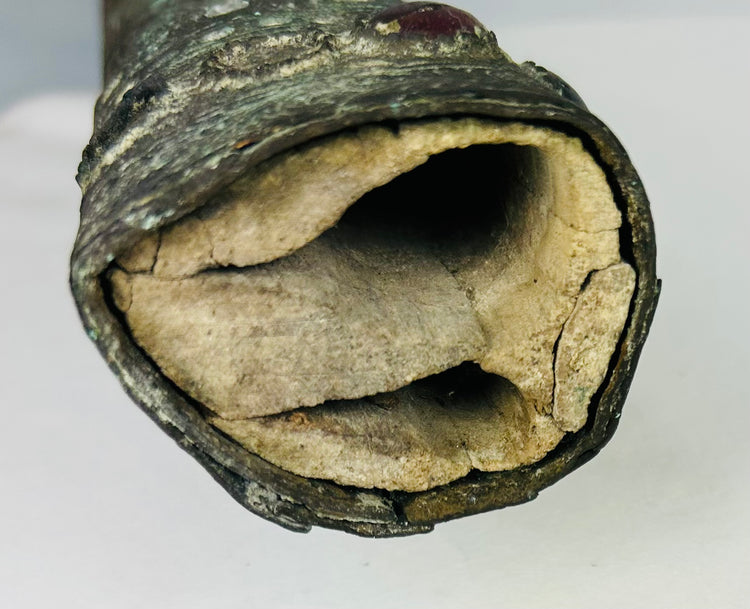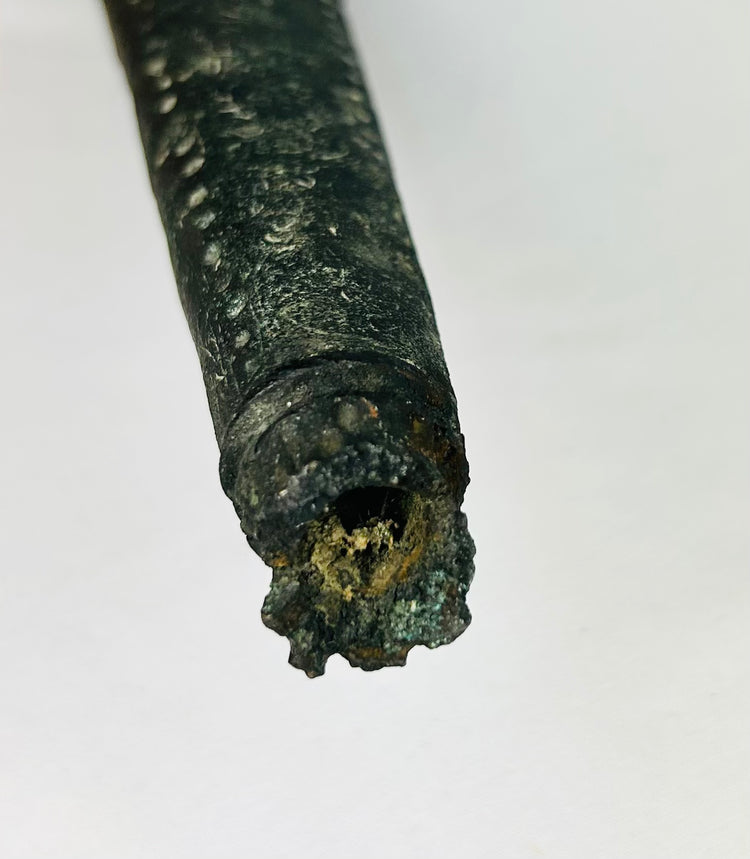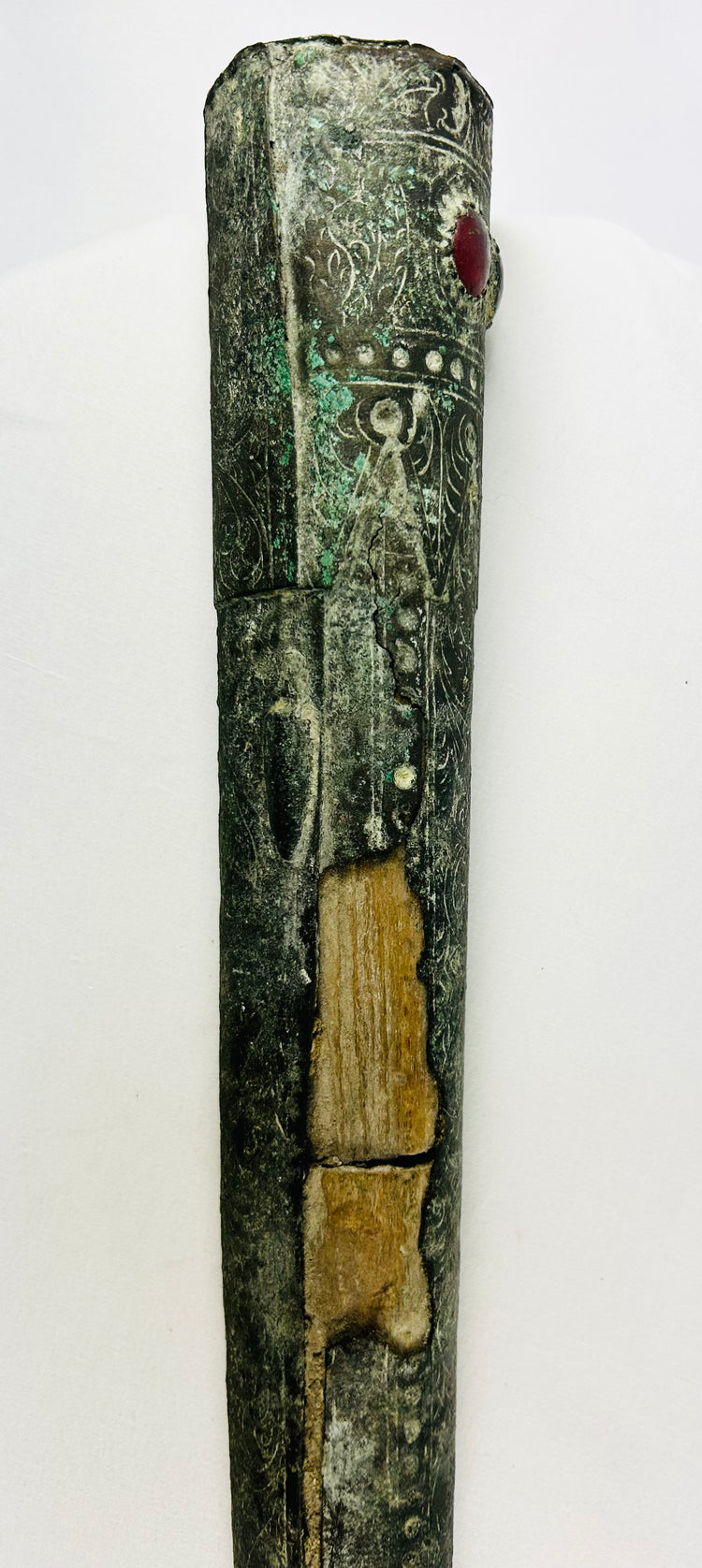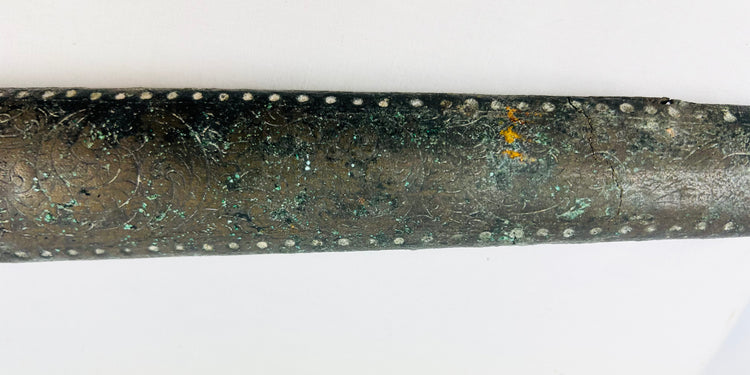Vaina de espada de bronce etrusca antigua | Artefacto de guerrero de alto rango | 900–700 a. C.
Descripción
Más
Menos
Contexto histórico y origen
Región: Etruria (actual Toscana y Lacio, Italia)
Material: Bronce con incrustaciones de piedras preciosas.
Periodo: 900–700 a. C.
Descripción
Esta exquisita vaina de espada de bronce es un ejemplo excepcional e importante de la artesanía etrusca temprana. Con una longitud aproximada de 45 cm, la vaina está decorada con intrincadas líneas grabadas, ornamentación perforada e incrustaciones de piedras preciosas en tonos rojos y oscuros, lo que refleja prestigio y maestría. La fina ejecución de los detalles y su carácter ceremonial sugieren que fue creada para un noble o guerrero de alto rango, representando tanto el poder marcial como el estatus aristocrático. Una rica pátina verde, desarrollada a lo largo de siglos, realza aún más su autenticidad y presencia visual.
Características
- Elaborada decoración grabada y perforada.
- Incrustaciones de piedras preciosas en tonos rojos y oscuros, que simbolizan riqueza y poder.
- Bronce forjado a mano con una artesanía excepcional.
- Rica pátina que da testimonio de una gran antigüedad.
Importancia cultural
Los etruscos, que florecieron entre los siglos IX y VI a. C., fueron reconocidos por su avanzada metalurgia y su sofisticada artesanía, lo que influyó enormemente en la cultura romana. Las vainas decorativas de bronce como esta no eran meramente funcionales, sino que constituían símbolos de estatus de los guerreros de élite, a menudo utilizadas en ceremonias o encargos prestigiosos. Esta vaina ejemplifica el refinamiento de las tradiciones marciales etruscas y el énfasis cultural otorgado a las armas como herramienta de guerra y emblema de identidad.
Condición
Extraordinariamente bien conservada, con pátina original y piedras incrustadas visibles. El desgaste superficial, propio de su antigüedad, realza su autenticidad.
Dimensiones (aproximadas)
Longitud: 18 pulgadas
Edad
900–700 a. C.
Descripción
Contexto histórico y origen
Región: Etruria (actual Toscana y Lacio, Italia)
Material: Bronce con incrustaciones de piedras preciosas.
Periodo: 900–700 a. C.
Descripción
Esta exquisita vaina de espada de bronce es un ejemplo excepcional e importante de la artesanía etrusca temprana. Con una longitud aproximada de 45 cm, la vaina está decorada con intrincadas líneas grabadas, ornamentación perforada e incrustaciones de piedras preciosas en tonos rojos y oscuros, lo que refleja prestigio y maestría. La fina ejecución de los detalles y su carácter ceremonial sugieren que fue creada para un noble o guerrero de alto rango, representando tanto el poder marcial como el estatus aristocrático. Una rica pátina verde, desarrollada a lo largo de siglos, realza aún más su autenticidad y presencia visual.
Características
- Elaborada decoración grabada y perforada.
- Incrustaciones de piedras preciosas en tonos rojos y oscuros, que simbolizan riqueza y poder.
- Bronce forjado a mano con una artesanía excepcional.
- Rica pátina que da testimonio de una gran antigüedad.
Importancia cultural
Los etruscos, que florecieron entre los siglos IX y VI a. C., fueron reconocidos por su avanzada metalurgia y su sofisticada artesanía, lo que influyó enormemente en la cultura romana. Las vainas decorativas de bronce como esta no eran meramente funcionales, sino que constituían símbolos de estatus de los guerreros de élite, a menudo utilizadas en ceremonias o encargos prestigiosos. Esta vaina ejemplifica el refinamiento de las tradiciones marciales etruscas y el énfasis cultural otorgado a las armas como herramienta de guerra y emblema de identidad.
Condición
Extraordinariamente bien conservada, con pátina original y piedras incrustadas visibles. El desgaste superficial, propio de su antigüedad, realza su autenticidad.
Dimensiones (aproximadas)
Longitud: 18 pulgadas
Edad
900–700 a. C.
También te puede interesar
































